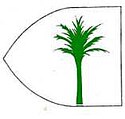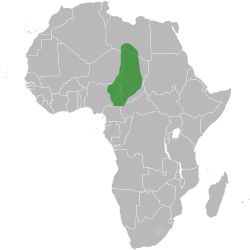| Revision as of 01:55, 18 May 2017 editVerbcatcher (talk | contribs)Extended confirmed users39,916 edits Undid revision 780771370 by 96.227.222.135 (talk) WP:NOTBROKEN, a specific article may appear← Previous edit | Revision as of 20:03, 16 August 2017 edit undoMarcocapelle (talk | contribs)Extended confirmed users, Page movers557,200 edits removed Category:History of Libya; added Category:History of Fezzan using HotCatNext edit → | ||
| Line 117: | Line 117: | ||
| ] | ] | ||
| ] | ] | ||
| ] | ] | ||
| ] | ] | ||
| ] | ] | ||
Revision as of 20:03, 16 August 2017
| This article needs additional citations for verification. Please help improve this article by adding citations to reliable sources. Unsourced material may be challenged and removed. Find sources: "Kanem Empire" – news · newspapers · books · scholar · JSTOR (April 2014) (Learn how and when to remove this message) |
| It has been suggested that this article be merged into Kanem–Bornu Empire. (Discuss) Proposed since April 2016. |
| Kanem Empire | |||||||
|---|---|---|---|---|---|---|---|
| c. 700–1387 | |||||||
 Flag of Kanem also known as Organa from Dulcerta atlas 1339
Flag of Kanem also known as Organa from Dulcerta atlas 1339 | |||||||
 Influence of Kanem Empire around 1200 AD Influence of Kanem Empire around 1200 AD | |||||||
| Capital | Njimi | ||||||
| Common languages | Tedaga | ||||||
| Religion | traditional beliefs, later Islam | ||||||
| Government | Monarchy | ||||||
| King (Mai) | |||||||
| • c. 700 | Sef | ||||||
| • 1382–1387 | Omar I | ||||||
| Historical era | Middle Ages | ||||||
| • Established | c. 700 | ||||||
| • Invaded and forced to move, thus establishing new Bornu Empire | 1387 | ||||||
| Area | |||||||
| 1200 | 776,996 km (300,000 sq mi) | ||||||
| |||||||
| Part of a series on the |
|---|
| History of Northern Nigeria |
 |
| Timeline |
| By ethnicity |
| By topic |
| By state |
The Kanem Empire (c. 700–1376) was located in the present countries of Chad, Nigeria and Libya. At its height it encompassed an area covering not only most of Chad, but also parts of southern Libya (Fezzan) and eastern Niger, northeastern Nigeria and northern Cameroon. The history of the Empire is mainly known from the Royal Chronicle or Girgam discovered in 1851 by the German traveller Heinrich Barth.
Origins
The empire of Kanem began forming around AD 300 under the nomadic Tebu-speaking Kanembu. According to the Girgam, the Kanembu were forced southwest towards the fertile lands around Lake Chad by political pressure and desiccation in their former range. The area already possessed independent, walled city-states belonging to the Sao culture. Under the leadership of the Duguwa dynasty, the Kanembu would eventually dominate the Sao, but not before adopting many of their customs. War between the two continued up to the late 16th century.
One theory proposes that the lost state of Agisymba (mentioned by Ptolemy in the middle of the 2nd century AD) was the antecedent of the Kanem Empire.
Duguwa Dynasty (Kanembu)
Main article: Duguwa DynastyKanem was located at the southern end of the trans-Saharan trade route between Tripoli and the region of Lake Chad. The Kanembu eventually abandoned their nomadic lifestyle and founded a capital around 700 AD under the first documented Kanembu king ("mai") known as Sef of Saif. The capital of N'jimi (the word for "south" in the Teda language) grew in power and influence under Sef's son, Dugu. This transition marked the beginning of the Duguwa Dynasty. The mais of the Duguwa were regarded as divine kings and belonged to the ruling establishment known as the Magumi. Despite changes in dynastic power, the magumi and the title of mai would persevere for over a thousand years.
Kanem is mentioned as one of three great empires in Bilad el-Sudan, by Al Yaqubi in 872.
Sayfawa Dynasty
Main article: Sayfawa DynastyThe major factor that later influenced the history of the state of Kanem was the early penetration of Islam. North African traders, Berbers and Arabs, brought the new religion. In 1085, a Muslim noble by the name of Hummay removed the last Duguwa king Selma from power and thus established the new dynasty of the Sefuwa.
The introduction of the Sefuwa dynasty meant radical changes for the Kanem Empire. First, it meant the Islamization of the court and state policies. Second, the identification of founders had to be revised.
Islam and Kanem
Islam offered the Sayfawa rulers the advantage of new ideas from Arabia and the Mediterranean world, as well as literacy in administration. But many people resisted the new religion, favouring traditional beliefs and practices. When Hummay had assumed power on the basis of his strong Islamic following, for example, it is believed that the Duguwa/Sefuwa began some kind of internal opposition. This pattern of conflict and compromise with Islam occurs repeatedly in Chad's history.
By the 12th century, the Sayfawa ruled all over Kanem. At the same time, the Kanembu people drew closer to the new rulers and increased the growing population in Njimi. Even though the Kanembu became the main power base of the Sayfawa, Kanem's rulers continued to travel frequently throughout the kingdom and especially towards Bornu, west of lake Chad. Herders and farmers alike recognized the government's power and acknowledged their allegiance by paying tribute.
Mai Dunama Dabbalemi
Kanem's expansion peaked during the long and energetic reign of Mai Dunama Dabbalemi (ca. 1221–1259), also of the Sayfawa dynasty. Dabbalemi initiated diplomatic exchanges with sultans in North Africa and apparently arranged for the establishment of a special hostel in Cairo to facilitate pilgrimages to Mecca. During his reign, he declared jihad against the surrounding tribes and initiated an extended period of conquest. After consolidating their territory around Lake Chad, the Fezzan region (in present-day Libya) fell under Kanem's authority, and the empire's influence extended westward to Kano (in present-day Nigeria), eastward to Ouaddaï, and southward to the Adamawa grasslands (in present-day Cameroon). However, he also destroyed the national Mune cult and thus precipitated widespread revolt culminating in the uprise of the Tubu and the Bulala. The former could be quenched but the latter continued to linger on and finally led to the retreat of the Sayfuwa from Kanem to Bornu c. 1380.
Dabbalemi devised a system to reward military commanders with authority over the people they conquered. This system, however, tempted military officers to pass their positions to their sons, thus transforming the office from one based on achievement and loyalty to the mai into one based on hereditary nobility. Dabbalemi was able to suppress this tendency, but after his death, dissension among his sons weakened the Sayfawa Dynasty. Dynastic feuds degenerated into civil war, and Kanem's outlying peoples soon ceased paying tribute.
Fall of Kanem
After the death of Dunama II, Kanem quickly fell into a downward spiral. By the end of the 14th century, internal struggles and external attacks had torn Kanem apart.
Sao Resurgence
Between 1342 and 1352, the Sao, who had dominated Kanem prior to the Zaghawa, killed four mais in battle. The proliferation of mai claimants to the throne led to a series of internecine wars. It became a problem for them to rule.
Bulala Invasion
The death knell of Sayfawa power in Kanem was dealt by the Bulala, invaders from the area around Lake Fitri to the east. By 1376, the Bulala had driven the Sayfawa from their capital. By 1388, they had taken Kanem altogether. The Kanuri were forced back into their nomadic ways and migrated west of Lake Chad, eventually establishing a new empire in Bornu.
See also
References
- Shillington, page 733
- "Kanem-Bornu". Encyclopædia Britannica. Retrieved 24 September 2014.
- "The Mune as the Ark of the Covenant between Duguwa (Kanembu) and Sefuwa (Kanembu - Mayi)" Borno Museum Society Newsletter 66-67 (2006), 15-25. (The article has a map (page 6) of the ancient Central Sahara and proposes to identify Agisymba of 100 CE with the early Kanem state).
- Levtzion, Nehemia (1973). Ancient Ghana and Mali. New York: Methuen & Co Ltd. p. 3. ISBN 0841904316.
Sources
- Shillington, Kevin (2005). Encyclopedia of African History Volume 1 A-G. New York: Routledge. pp. 1912 pages. ISBN 1-57958-245-1.
- Kanem-Borno, in Thomas Collelo, ed. Chad: A Country Study. Washington: GPO for the Library of Congress, 1988.
- Lange, Dierk: "The Chad region as a crossroads", in: M. Elfasi (Hg.), General History of Africa, vol. III, UNESCO, London 1988, p. 436-460.
- Lange, Dierk, "The kingdoms and peoples of Chad", in: D. T. Niane (ed.), General History of Africa, vol. IV, UNESCO, London 1984, p. 238-265.
Further reading
- Barkindo, Bawuro, "The early states of the Central Sudan: Kanem, Borno and some of their neighbours to c. 1500 A.D.", in: J. Ajayi und M. Crowder (Hg.), History of West Africa, Bd. I, 3. Ausg. Harlow 1985, 225-254.
- Lange, Dierk, Ancient Kingdoms of West Africa: Africa-Centred and Canaanite-Israelite Perspectives, Dettelbach 2004. (the book suggests a pre-Christian origin of Kanem in connection with the Phoenician expansion)
- Urvoy, Yves, L'empire du Bornou, Paris 1949.
- Lange, Dierk, "Immigration of the Chadic-speaking Sao towards 600 BCE" Borno Museum Society Newsletter, 72-75 (2008), 84-106.
External links
Categories:
- Articles to be merged from April 2016
- Kanem Empire
- States of Ancient Africa
- States of medieval Africa
- Muslim empires
- Sahelian kingdoms
- History of Central Africa
- History of Cameroon
- History of Chad
- History of Fezzan
- History of Niger
- History of Northern Nigeria
- States and territories established in the 700s
- States and territories disestablished in 1387
- Former countries in Africa
- 8th century in Africa
- 9th century in Africa
- 10th century in Africa
- 11th century in Africa
- 12th century in Africa
- 13th century in Africa
- 14th century in Africa